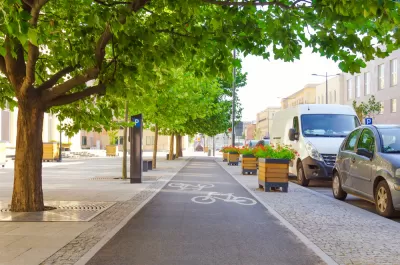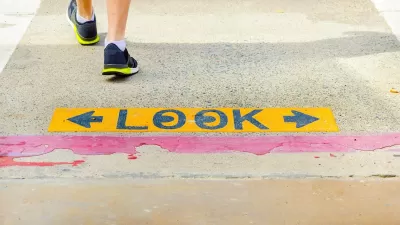A bill named in honor of a U.S. diplomat killed while on her bicycle would let state DOTs access full federal funding for road safety projects.

A federal list of road design elements called “proven safety countermeasures” could hold the key to improved road safety, says former Federal Highway Administration Administrator Shailen Bhatt.
As Kea Wilson explains in Streetsblog USA, “these measures offer safety benefits that have been meticulously proven and quantified by U.S. DOT itself, in the hyper-specific contexts in which traffic engineers might use them — a far higher and more important bar to clear in the bureaucratic world of state DOTs.”
Currently, state DOTs must offer a 10 percent match to receive federal funding for safety projects, meaning they’re often deprioritized in states with low resources. A proposed bill, the Sarah Debbink Langenkamp Act, would allow state DOTs to use 100 percent federal money for safety measures, eliminating the 10 percent local match. “Even as America enters an uncertain new era, supporters of the Langenkamp bill say strategies like protected bike lanes are becoming increasingly normalized in the minds of American transportation officials, thanks in no small part to their status as a proven safety countermeasures.”
According to Wilson, “Increasing state control over how communities make their roads safer is a message that advocates hope a GOP-held Congress can get behind — especially since the bill wouldn't touch a separate federal law that prohibits states from spending more than 10 percent of their total safety money on projects for which the federal government is paying 100 percent of the cost.”
FULL STORY: One Hidden Reason Why Your State DOT Isn’t Building Protected Bike Lanes

Alabama: Trump Terminates Settlements for Black Communities Harmed By Raw Sewage
Trump deemed the landmark civil rights agreement “illegal DEI and environmental justice policy.”

Planetizen Federal Action Tracker
A weekly monitor of how Trump’s orders and actions are impacting planners and planning in America.

Why Should We Subsidize Public Transportation?
Many public transit agencies face financial stress due to rising costs, declining fare revenue, and declining subsidies. Transit advocates must provide a strong business case for increasing public transit funding.

Understanding Road Diets
An explainer from Momentum highlights the advantages of reducing vehicle lanes in favor of more bike, transit, and pedestrian infrastructure.

New California Law Regulates Warehouse Pollution
A new law tightens building and emissions regulations for large distribution warehouses to mitigate air pollution and traffic in surrounding communities.

Phoenix Announces Opening Date for Light Rail Extension
The South Central extension will connect South Phoenix to downtown and other major hubs starting on June 7.
Urban Design for Planners 1: Software Tools
This six-course series explores essential urban design concepts using open source software and equips planners with the tools they need to participate fully in the urban design process.
Planning for Universal Design
Learn the tools for implementing Universal Design in planning regulations.
Caltrans
Smith Gee Studio
Institute for Housing and Urban Development Studies (IHS)
City of Grandview
Harvard GSD Executive Education
Toledo-Lucas County Plan Commissions
Salt Lake City
NYU Wagner Graduate School of Public Service





























